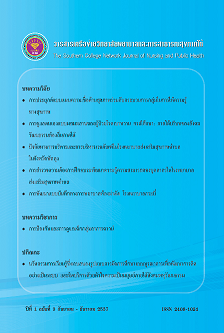การพัฒนาแบบบันทึกทางการพยาบาลห้องผ่าตัด โรงพยาบาลกระบี่
คำสำคัญ:
บันทึกทางการพยาบาล, การพยาบาลห้องผ่าตัด, Nursing Documentation, Perioperative Nursingบทคัดย่อ
การศึกษาครั้งนี้เป็นการวิจัยและพัฒนา มีวัตถุประสงค์เพื่อพัฒนาแบบบันทึกทางการพยาบาลห้องผ่าตัด โรงพยาบาลกระบี่ โดยใช้กระบวนการพยาบาลใน 3 ระยะของการผ่าตัดคือระยะก่อนผ่าตัดระยะผ่าตัดและระยะหลังผ่าตัด ดำเนินการวิจัยแบ่งออกเป็น 3 ระยะคือระยะที่ 1 วิเคราะห์สถานการณ์ระยะที่ 2 ดำเนินการพัฒนาแบบการบันทึกทางการพยาบาลผู้ป่วยผ่าตัด ระยะที่ 3 ประเมินผลการพัฒนากลุ่มตัวอย่างประกอบด้วย 1) กลุ่มพัฒนาแบบบันทึกทางการพยาบาลห้องผ่าตัดจำนวน 30 คน 2) กลุ่มผู้ใช้แบบบันทึกทางการพยาบาลจำนวน 18 คน 3) กลุ่มผู้ป่วยผ่าตัดที่นอนพักรักษาในโรงพยาบาลกระบี่ระหว่างวันที่ 1 ตุลาคม – 31 ธันวาคม 2553 จำนวนทั้งสิ้น 119 คน เครื่องมือในการดำเนินการวิจัยประกอบด้วย 1) แบบตรวจสอบคุณภาพการบันทึกทางการพยาบาลใช้หลัก 4C ตามเกณฑ์ของสำนักการพยาบาล 2) แบบสอบถามความพึงพอใจของผู้ป่วยผ่าตัดต่อคุณภาพบริการพยาบาลที่ได้รับได้ค่าความเที่ยงของแบบสอบถามเท่ากับ .89 วิเคราะห์ข้อมูลโดยการวิเคราะห์เนื้อหา ค่าเฉลี่ย และร้อยละ
ผลการศึกษาพบว่า 1) ระยะวิเคราะห์สถานการณ์วางแผนพัฒนา ยังไม่มีรูปแบบของการบันทึกทางการพยาบาลที่ใช้กระบวนการพยาบาลทั้ง 3 ระยะของการผ่าตัด การเขียนบันทึกทางการพยาบาลเขียนในบันทึกทางการพยาบาลร่วมกับหอผู้ป่วย 2) ระยะพัฒนาแบบบันทึกทางการพยาบาล โดยใช้กระบวนการพยาบาลใน 3 ระยะของการผ่าตัด ตามเกณฑ์มาตรฐานของสำนักการพยาบาล มีการกำหนดข้อวินิจฉัยทางการพยาบาล การปฏิบัติกิจกรรมการพยาบาล และการประเมินผลการปฏิบัติในทุกระยะของการผ่าตัด 3) ระยะประเมินผลการพัฒนา ด้านการตรวจสอบคุณภาพการบันทึกทางการพยาบาลโดยใช้หลัก 4C ตามเกณฑ์ของสำนักการพยาบาลพบว่า มีการบันทึกได้ครบถ้วน ถูกต้อง ชัดเจนได้ใจความ คิดเป็นร้อยละ 75.4 ความไม่ครบถ้วนสมบูรณ์ของแบบบันทึกทางการพยาบาลห้องผ่าตัดพบว่าเป็นข้อวินิจฉัยทางการพยาบาล เป้าหมาย และการประเมินผลมีความครบถ้วนสมบูรณ์เพียงร้อยละ 34.5
The Development of Perioperative Nursing Documentation in Krabi Hospital.
This research and development aimed to develop perioperative nursing documentation based on the nursing process including preoperative, intraoperative, and post-operative nursing care. The research process was divided into 3 phases: 1) situation analysis and planning phase, 2) developing perioperative nursing documentation, and 3) evaluation. Samples were 3 groups: 1) thirty (30) registered nurses who were working in operating room and developed the perioperative nursing documentation, 2) eighteen (18) registered nurses who used the perioperative nursing documentation, and 3) one hundred and nineteen (119) patients who were admitted in the hospital between October First, 2010 and December 31, 2011.The research instruments were: 1) checklist of the perioperative nursing documentation’s quality, based on the 4C criteria of Nursing center, 2) questionnaires regarding the surgical patients’ satisfaction toward a quality of nursing care. Reliability of the questionnaire was tested using Cronbach’s Alpha Coefficient and equal to .89. The data were analyzed using mean, percentage, and content analysis. The results revealed as following.
1. The operative nursing documentation was developed (including the three phases of surgery) based on the nursing process following the standard care as recommended by the Nursing center. The three main categories providing continuing of perioperative care were nursing diagnosis setting, nursing intervention, and nursing evaluation.
2. The quality of the perioperative nursing documentation was complete, accurate, clear, and concise (75.4%). The incompleteness of the perioperative nursing documentation were nursing diagnosis, goal of nursing care, and nursing evaluation (34.5%).
The utilities of the perioperative nursing documentation were as follows: patients were closely monitored, nurses used as guidelines for nursing care, the hospital used as a tool for nursing standard and nursing quality check in order to improve the quality of patient care. After using the perioperative nursing documentation, the patient’s satisfaction regarding quality of nursing care was significantly higher than before using it (61.64% in 2009 and 85.4% in 2010).
ดาวน์โหลด
เผยแพร่แล้ว
ฉบับ
ประเภทบทความ
สัญญาอนุญาต
1. บทความหรือข้อคิดเห็นใด ๆ ที่ปรากฏในวารสารเครือข่าย วิทยาลัยพยาบาลและการสาธารณสุขภาคใต้ ที่เป็นวรรณกรรมของผู้เขียน บรรณาธิการหรือเครือข่ายวิทยาลัยพยาบาลและวิทยาลัยการสาธารณสุขภาคใต้ ไม่จำเป็นต้องเห็นด้วย
2. บทความที่ได้รับการตีพิมพ์ถือเป็นลิขสิทธิ์ของ วารสารเครือข่ายวิทยาลัยพยาบาลและการสาธารณสุขภาคใต้








